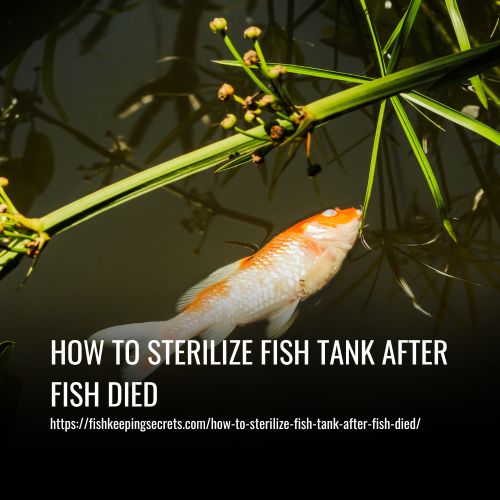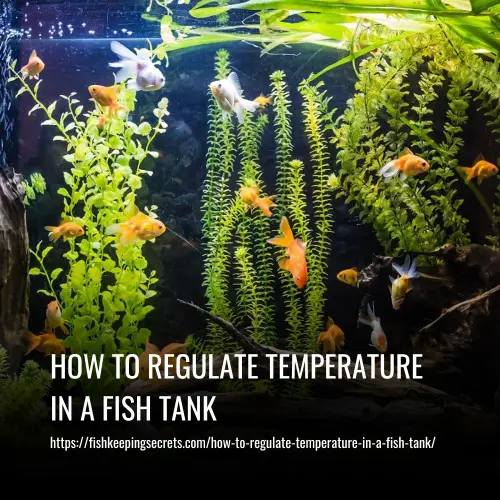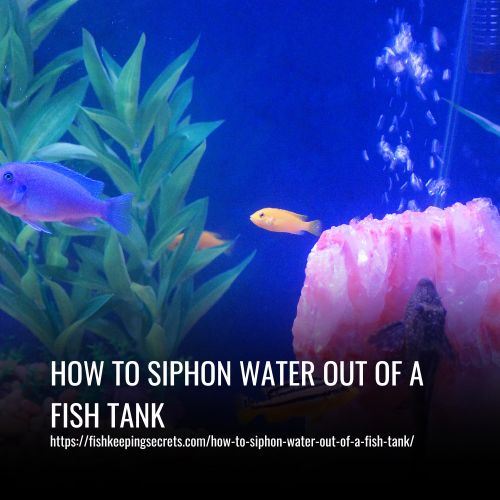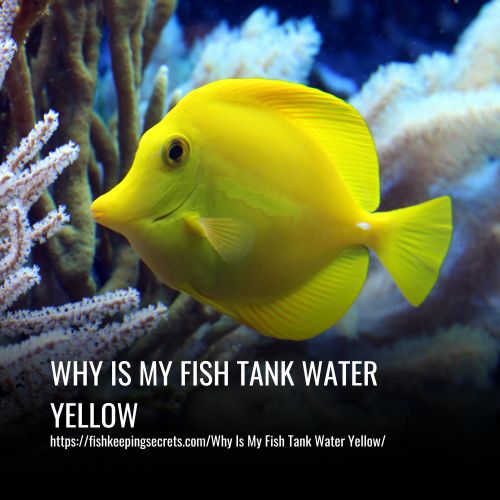How To Sterilize Fish Tank After Fish Died
This post contains affiliate links. As an Amazon Associate, we earn from qualifying purchases.
It is not uncommon for fish, unfortunately, to die in an aquarium from time to time. As a fishkeeper, though, it is your responsibility to address this issue quickly and appropriately. How can you do that? By sterilizing the entire fish tank after a fish has died in it.
To Sterilize the Fish Tank After the Fish Died, follow these steps:
- Breaking the Fish Tank.
- Make Water Changes.
- Removing and Cleaning the Gravel and other Accessories.
- Replacing Filter Media.
- Disinfect The Tank.

Sterilize Fish Tank After Fish Died
To properly sterilize a fish tank after the death of a fish, it is important to act quickly and take all necessary steps:
1. Breaking the Fish Tank:
If your fish has died, it’s important to know how to properly sterilize your fish tank. The best way to do this is by bleaching every single thing in the aquarium, from the gravel and walls to any decorations or plants inside.
Start by rinsing everything off with water completely, before making sure that all the surfaces have been sanitized and cleaned with bleach. Once you are done, it’s also important that you heavily dechlorinate everything so no harmful chemicals remain in your fish tank.
By taking these steps, you can ensure that your fish tank is fully sanitized and safe for future use.
2. Make Water Changes:
When a fish in your tank dies, it is paramount that you sterilize the aquarium. One of the first steps to do so is making water changes. This ensures that any waste, toxins, and residual chlorine from the water supply can be removed.
With each water change, dechlorinate the fresh water before putting it into the tank, and keep doing this until there are no more traces of chlorine in the aquarium. This should help in getting rid of any bad odors present as well.
3. Removing and Cleaning the Gravel and other Accessories:
If you want to get your fish tank back in pristine condition after a fish has died, one of the first steps is to remove and clean the gravel and other accessories. I recommend spreading all the gravel out under direct sunlight multiple times, as this should help to sterilize it.
You’ll also need to use bleach to thoroughly clean up any remaining debris. Once everything has been cleaned and dried, you’ll be able to put it back into the aquarium and treat it like new again.
4. Replacing Filter Media:
If you want to properly sterilize your fish tank after the unfortunate loss of a fish, then you need to replace all existing filter media. It’s not enough just to remove the dead fish – you need to start fresh for the health and safety of any new inhabitants.
By replacing your filter media, you get rid of any debris or bacteria that might remain from your old setup. This ensures that when you cycle your tank again by adding new inhabitants, it is done in a clean and safe environment. Replacing your filter media will also help improve water clarity and quality, ensuring the best possible conditions for any new occupants!
5. Disinfect The Tank:
When the water quality in a tank has deteriorated due to dead fish, it’s important to properly disinfect it. This is just as important as any lab environment studying fish where measures must be taken to prevent the spread of pathogens and the buildup of waste products, according to the Journal of the American Association for Laboratory Animal Science.
For standard aquarium sanitation, a natural vinegar solution can be used to clean and disinfect your tank. But if your fish passed away due to sickness or disease, using a bleach solution will be necessary in order to kill off any harmful pathogens. Following the instructions on how to use these solutions properly is key to ensuring that your tank is sufficiently sanitized and clean.
Bleach Solution
The best way to disinfect a fish tank is by using a bleach solution. You should always use standard household bleach, as other detergents could corrode the tank. For the solution, mix 8 parts water and one part bleach. When filling the entire tank with the solution, use warm water to help the bleach dissolve.
Also, before you begin cleaning make sure that all your surviving fish are removed into a separate tank. Once you have poured the solution into a spray bottle, spray it inside of your tank and leave it for about 10 minutes. Then be sure to rinse off the tank thoroughly and let it air dry for 24 hours to ensure that all of the residual bleach has been removed from the aquarium walls.
After you’ve followed all these steps, your aquarium will be ready! But don’t forget to scrub any ornaments or decorations to remove leftover dirt using the same ratio of bleach solution and a small brush until they are completely clean.
Vinegar Solution
The use of vinegar to clean and disinfect your tank is becoming a popular choice among fish owners. Not only is white vinegar less corrosive than bleach, but it’s also safer for the decorations and removable parts in your tank that you want to clean.
That’s why Nature Nutrition has created a special vinegar solution specifically made to provide a safe way to disinfect the tank. The solution consists of one part water and one part white vinegar, making it an effective yet gentle cleaning agent that won’t damage any parts of your tank or its decorations.
Simply fill the entire tank with this solution and let everything soak for a couple of hours to get rid of any build-up. If necessary, you can make stronger solutions with two parts vinegar and one part water for more persistent particles. Once everything is clean, simply rinse off the items before returning them back into your tank for their next use.
Cleaning a Fish Tank After the Fish Died
If your fish has died, don’t worry – there’s no need to automatically replace all the water in the aquarium. Despite common belief, a dead fish will not contaminate or foul the water and will not spread whatever killed them around the tank.
It is important to thoroughly and properly sanitize the fish tank after a fish dies. Here are some tips on how to do so:
1. Remove the Fish Immediately:
Removing a dead fish from your fish tank should be done as soon as possible. If you’re able to locate the deceased fish, removed it immediately. Even if the fish is lodged behind rocks and other obstacles, try and do your best to locate and extract the carcass, otherwise, it can cause disruption to the environment of the tank.
However, if you are unable to recover the fish due to the size of your tank with plenty of tanks inside or its location then don’t worry too much – there’s no harm in leaving it in there. The filter system should take care of any excess nutrients which it may produce.
2. Check on your Filtration System:
When cleaning a fish tank after the death of one of your fish, it is important to check on the filtration system. A strong filter can help keep the water clean from waste produced by the dead fish, and more importantly, it can remove any parasites or diseases that may have been spread due to their lack of a living host.
It’s best practice to remove the dead fish immediately in order to prevent the further spreading of disease, and if you don’t catch it straight away then fear not – there’s no need to worry because your tank’s filter should take care of everything. So make sure your filtration system is in good shape when dealing with a death in the tank!
3. Investigate and Test the Water:
If a fish in your tank is found dead, it is important to investigate and analyze the water quality. It could be that the water quality was actually the cause of your fish’s death, making it essential to test it. That way, you can immediately remedy any problems that are found, ensuring a healthy environment for future inhabitants of the tank.
Additionally, even if the water is fine, bacteria and other disease organisms may still exist in the tank at low levels. While this isn’t necessarily a good thing and steps should be taken to prevent these organisms from flourishing, it doesn’t mean that an outbreak is imminent or that cleaning out all the remaining fish is needed. So always investigate before taking any drastic actions!
4. Change the Water:
When a fish dies in your tank, it’s important to take the necessary steps to keep it clean and safe. One of the most important things you can do is to give your aquarium a large water change. This will help remove any bacteria or toxins that were built up due to the dead fish. Wait at least one to two weeks before adding new fish and resuming regular fish maintenance activities.
If the fish had white spot disease, it would be wise to raise the temperature up to 90 degrees Fahrenheit for three weeks before returning it back down and doing another large water change. Doing these steps as soon as possible is essential for maintaining a healthy environment in your aquarium.
5. Run the Fish Tank Without Fish:
When a fish dies in your fish tank, it is important to act quickly and remove the deceased fish. But running the tank without any fish for two weeks can also be beneficial. This allows you to check the water for any potential ammonia problems due to the dead fish and make sure everything is safe.
This method can even help kill any parasites that may be present. Usually, parasites come in cycles that last no longer than two weeks, so once you remove the fish and there’s nothing left for them to spread to they will die off naturally.
Running your tank without fish may sound like an odd idea, but it can be extremely helpful in ensuring your aquarium stays safe and healthy!
Preventing Disease From Coming Back
Preventing the disease from coming back into your tank should be a top priority. Following the tips outlined below, you can ensure your fish are kept healthy and the tank is free of disease.
To start, never add new fish to an existing tank habitat without first quarantining them to determine their health status – if they show signs of disease, make sure to remove them before introducing them into the environment. Feed your fish only good quality food and live foods from reputable sources that have not been infected with the disease.
Provide a clean and healthy habitat for your fish by ensuring filtration is working properly and doing regular water changes as well as cleaning out the tank at least once per week. Avoid transferring things between tanks such as nets – this could easily spread diseases to other residents of the tank.
By following these guidelines, you can put into practice maximal preventative measures when it comes to keeping your fish healthy and preventing the disease from returning!
How Long Does It Take For A Dead Fish To Decompose?
Decomposition isn’t an exact science and the amount of time it takes for a dead fish to decompose depends on several factors. This includes the water temperature, pH level, as well as type of fish.
Generally speaking, it could take anywhere from a few days to multiple weeks for a fish to completely break down. Of course, if you’re looking for more accurate timelines then you should look into specific data regarding different species and environments.
But one thing is certain; depending on the circumstances, you can expect your dead fish to start decaying relatively quickly.
FAQs
Fish that die from ich or any other cause must be immediately taken out of the water. Rotting fish can quickly contaminate the water and spread bacteria, which can be hazardous to other fish and aquarium pets. If you notice a dead fish in the tank, it should be removed right away.
A dead fish can typically decompose fully within 7 to 10 days, so it is advisable to remove the betta fish promptly upon its death.
The amount of time it takes for the bacteria in a fish tank to start the process of decay varies, but usually, it is estimated to occur within 4 days.
It is recommended to clean a fish tank approximately one or two times every two weeks, though the ideal frequency of cleanings can vary based on the type of tank and fish, as well as the amount of dirt present.
Cleaning your fish tank with vinegar is relatively straightforward, though it is crucial to stick to the five steps listed in order to ensure the safety of your fish.
After 24 hours of cleaning and sterilizing the fish tank gravel, the aquarium is ready to have fish reintroduced. The length of time from the completion of cleaning before the water becomes suitable for pet fish is 24 hours, during which friendly bacteria can begin to develop.
In some cases, dead fish may be present after a tank cleaning procedure, so it is important to allow time for the process to complete.
Conclusion:
Having a fish tank in your home can be a great addition, but also comes with certain responsibilities. When fish die, it is important to properly clean and sterilize the tank and water supply to avoid any further losses or health issues.
Taking precautionary steps such as doing water tests regularly, changing the water at least once a month, and not overcrowding the tank, are all excellent ways of keeping the fish healthy and avoiding these situations altogether. With proper care, you will be able to enjoy a healthy aquarium for many years to come.






